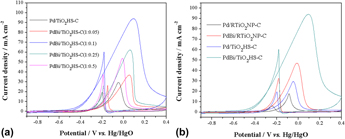No CrossRef data available.
Published online by Cambridge University Press: 22 November 2016

The TiO2 hollow spheres (TiO2HS) were successfully prepared by a hydrothermal method and added to Vulcan XC-72 carbon black as the support materials for Pd nanoparticles. A facile approach to promote ethylene glycol (EG) electrooxidation in alkaline medium was carried out by the PdBi/TiO2HS-C catalyst. The results show that Pd and Bi nanoparticles are uniformly dispersed on the surface of carbon-doped TiO2 hollow spheres, the appropriate amount of Bi modification into Pd/TiO2HS-C catalyst can enhance remarkably the electrocatalytic activity for EG oxidation, in which the PdBi/TiO2HS-C (Pd:Bi = 1:0.1) catalyst exhibits excellent stability. The high electrochemical performance is attributed to the unique structure and high surface area of the TiO2HS, metal nanoparticles uniform distribution, the electronic effect between Pd and Bi as well as the bifunctional effect between metal nanoparticles and the support TiO2HS-C. The results obtained are significant for the development of new Pd-based TiO2HS-C electrocatalysts for alcohol fuel cells.